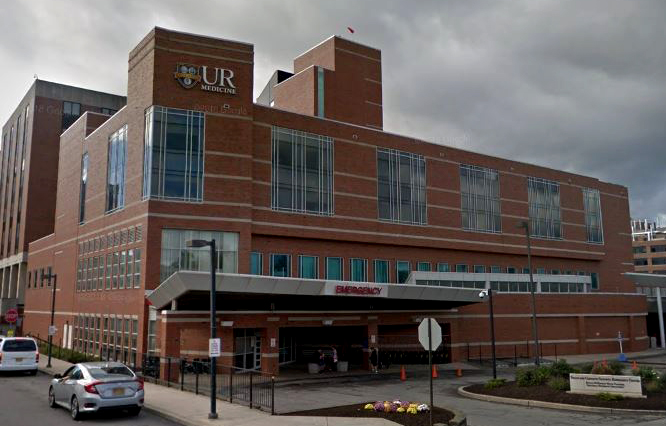
| Medical Center | Emergency
Department |
 |
| Emergency Department after vertical expansion completed. |
| Temporary surge structures were placed outside the ED to increase capacity during the time of Covid. | |
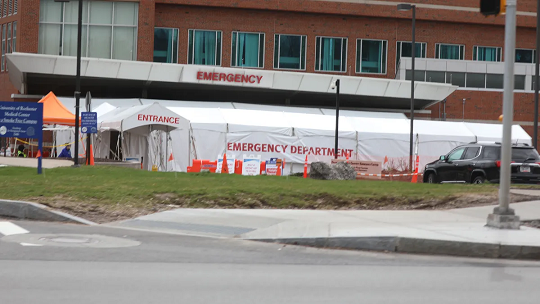 |
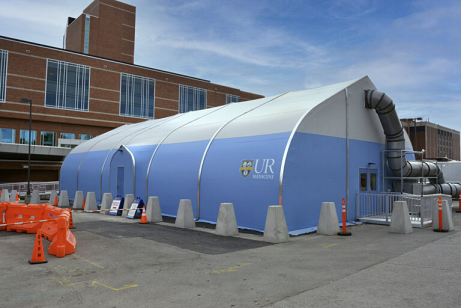 |
| March 2020 | October 2020 |
| Hospital Ambulances | ||||
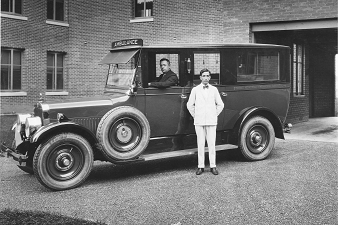 |
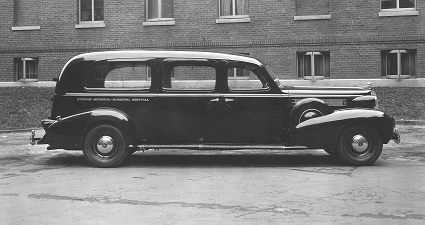 |
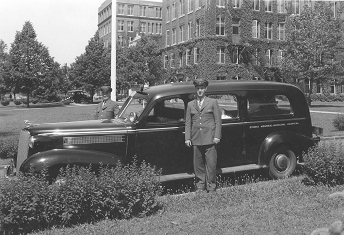 |
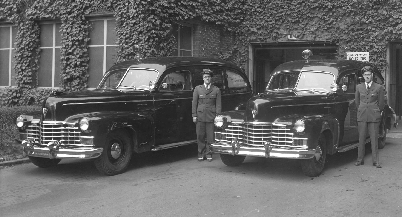 |
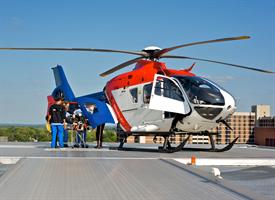 |
| 1926 |
1936 |
1940 |
1946 |
2011
Helicopter |
 |
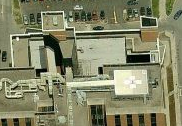 |
| Helipad around 1992 | Helipad on
top of Strong Hospital in 2010 |
The new Frank and Caroline Gannett Emergency Center was opened to patients on March 14, 2001 and included a new heliport on top of an adjacent hospital wing. Two floors were added in 2004 to house the Pediatric Intensive Care Unit, in-hospital Ronald McDonald House and an Burn/Adult Trauma Unit. The foundation for the 2001 building was value-engineered and only supported two additional floors, rather than the six that would otherwise be allowed.
The 2001 emergency department replaced a facility that opened in May 1976 at the then-new Strong Memorial Hospital. That facility in turn had replaced the original emergency rooms in the 1926 Strong Memorial Hospital.
A helipad was installed outside the 1976 Emergency Department in 1992 and a new helipad was built on top of the 1600 Tower of Strong Memorial Hospital in 2001, with dedicated elevators to bring patients to the Emergency Department.
A new project currently underway will expand the emergency department by demolishing several structures, including the autoclave, substation, S&A building, staff house and gymnasium to accommodate new tower(s) along the north side of the medical center.
References
1967 "New Quarters for Emergency Department," University Record
7(10):1 (November 1967)
1975 To
each his farthest star: The University of Rochester Medical
Center -1925-1975, edited by Edward C. Atwater and John
Romano.
Page 325: In the Emergency Department house staff responsibility has
become more complex. Rather than serving as a straightforward acute-care
facility the Emergency Department has become an extension of clinic and
community practice, so that patients come with minor problems, especially
nights and weekends. In 1967, the Emergency Department was expanded and
made more functional, with the addition of cubicles for nonacute patients
to complement the holding beds and the traditional acute area. Conference
rooms were added for the new Emergency Department Clerkship, where all
fourth-year students are required to spend a month in the Emergency
Department. The numbers of house staff assigned to the Emergency
Department have expanded, and they have the additional unique experience
of being responsible for teaching large numbers of students who are based
in the facility. In July 1963, house staff as well as senior staff were
acutely tested shortly after the arrival of new interns, when a commercial
airplane crashed at Monroe County Airport and 36 patients arrived at the
Strong Memorial Hospital Emergency Department. All of the injured who
reached the Hospital lived, and television sets given by a grateful
company, many of whose employees were on the flight, still are present on
the Hospital patient-floor porches.
Page 485: Strong in fifty years has had but one disaster test. In
July 1963 a Mohawk plane crashed in bad weather at Monroe County Airport.
Despite the failure of the airport to flash any warning to the hospital,
Strong was quickly in action with all of its facilities, taking care of 30
victims dumped into emergency and corridors. Grateful for the costly
services rendered several injured employees, IBM sent the Hospital
$10,000.
1976 "Gannett
Center Dedicated at SMH," Rochester Review 34(4):35 (Summer
1976)
The Strong Memorial Hospital dedicated its new Frank and Caroline Gannett
Emergency Center on May 1 in the main dining room of the hospital. The new
Center went into full operation on May 4. Speakers at the dedication
were Mrs. Frank E. Gannett; John A. Scott, president of the Frank E.
Gannett Newspaper Foundation, Inc., and Dr. John H. Morton, clinical
director of the Emergency Center. President Sproull presided at the
ceremonies. Gifts of $750,000 from the Gannett Foundation and
$500,000 from Mrs. Gannett provided the necessary funds to cover the cost
of completing the Center. Only the shell for the emergency unit was
completed at the time the new Strong Memorial Hospital was constructed;
development of the Center was made possible with the Gannett gifts.
Maximum efficiency in the use of floor space has been achieved in the new
Center, which occupies 22,000 square feet in contrast to 24,000 square
feet in the old emergency area.
1986 "Police
helicopter crashes," Democrat and Chronicle, April 12, 1986,
Page B1.
A state police helicopter with a medical team aboard hit a tree limb
yesterday and crashed during takeoff from Strong Memorial Hospital. No one
was injured in the 10:50 a.m. accident near a loading dock on the Elmwood
Avenue side of the hospital, said hospital spokesman Milton Lederman. The
helicopter was to fly a doctor and two nurses to F.F. Thompson Memorial
Hospital in Canandaigua to pick up a sick baby and return to Strong. Dr.
Steven Benn and nurses Sharon Cohen and Jean Kirby boarded the helicopter,
piloted by state police Sgt Kenneth Hunt The helicopter lifted off from
its concrete pad and veered toward a tree, "as if there was a sudden wind
gust," Lederman said. He said it was about 20 or 30 feet above the ground
when its rotor struck a tree limb, snapping a blade. The Federal Aviation
Administration is investigating the crash.
1992 "Lack
of Helipad at hospital still an issue," Democrat and Chronicle,
February 20, 1986, Page 6B. | correction
|
Air ambulance can't set down at Strong center.
1992 "Copters
now can land at Strong," Democrat and Chronicle, June 25,
1992, Page 8B.
Temporary helipad boon to patients. Strong announced it has arranged a
temporary landing site at the hospital while it continues work on a
permanent helipad. The landing area is a grassy field on Crittenden
Boulevard, about 100 yards from the hospital's Emergency Department
entrance.
2001 "Strong
opens New ER today," Democrat and Chronicle, March 6, 2001,
Page 1B.
Strong Memorial Hospital plans to cut the ribbon today on its new $22
million emergency department.
But the new facility won't be in use until next week. Hospital officials
plan to move staff and equipment to the new facility next Tuesday and
Wednesday. That night, they will keep both facilities open and gradually
transfer patients depending on their severity, said Dr. Frank Zwemer Jr.,
vice chairman for clinical affairs for the department of emergency
medicine.
The ribbon will be cut at 2 p.m. today on the new Frank and Caroline
Gannett Emergency Center, which at 55,000 square feet is triple the size
of the current trauma unit.
The three-story building, located next to the hospital's Elmwood Avenue
entrance, includes new pediatric and psychiatric areas, an elevator tower
and a rooftop helipad. It also expands Strong's urgent care services and
an area where patients are kept for observation.
Roughly 200 patients a day visit Strong's emergency room.
Strong will now be able to treat 59 patients at a time, compared with 40
in the old unit. Each room is designed for one person, but is large enough
to add another bed.
Modeled after the University of Cincinnati's emergency department,
Strong's facility features a main adult acute care area with a central
nurse's station surrounded by 25 rooms. The station is elevated, and
surrounded by glass so nurses and physicians can see into each room, yet
walls divide patient rooms.
The trauma bay contains large rooms for critically ill patients, plus
enough room for emergency operations.
Two of the rooms contain digital X-ray machines, and there is also a new
CT scanner, so the department will no longer have to share either with the
rest of the hospital.
The new department also features a separate, mural-lined pediatric unit
and waiting area for the roughly 27,000 children it serves annually.
A $1 million donation from the Ronald McDonald House enabled the hospital
to add a child-life worker, plus physician and nurse education
opportunities, said Dr. Julius Goepp, director of the pediatric emergency
department.
"It's just breathtaking in size and in its child-friendliness," Goepp
said.
Basement space in the new building will be used to expand the hospital's
operating rooms, said Kathleen Parrinello, Strong's chief operating
officer.
The new emergency facility is a vast improvement, Parrinello said. In the
current facility, space is so limited that patients are often treated in
the hallway. Equipment, supplies and gurneys clog walkways. Patients who
walk in and those who arrive by ambulance must use the same door.
"We're very excited to move away from that," Parrinello said.
Planning began after a hospital committee deemed that a new emergency
department was badly needed in 1994, Parrinello said. In 1998, the
hospital received state approval to build a new facility and broke ground
in May 1999.
The hospital financed 90 percent of the project through bonds, while
donors provided the other 10 percent, she said.
2001 "New
Emergency Department opens," Currents 29(6), March 19, 2001
Patients needing emergency care at Strong Memorial Hospital now have
access to the region's largest and most modern emergency facility.
The new, 55,000-square-foot Frank and Caroline Gannett Emergency Center at
Strong began admitting patients last Wednesday.
The facility, more than three times larger than Strong's previous
emergency department, was unveiled March 6 after nearly two years of
construction.
Designed to improve efficiency in a facility that handles more than 75,000
visits per year, the center has been designated by the New York State
Department of Health as a Level One Regional Trauma Center.
"This new ED represents a vast improvement over our old facility in
virtually every way," said Kathleen Parrinello, chief operating officer
for Strong Memorial Hospital. "It has enough space to accommodate the
number of patients who rely on us for care, it is built with the dignity
and comfort of our patients in mind, and it is designed to aid us in
providing rapid care."
Modeled after the emergency department at the University of Cincinnati, a
medical center that is nationally respected for its emergency and trauma
services, the Gannett Emergency Center features distinct treatment areas
for adults and children, as well as for those who require urgent care for
minor injuries.
The Gannett Emergency Center is located on the north side of the Medical
Center campus, adjacent to the main hospital entrance and across from the
ramp garage.
2004 "Strong
Memorial boosted with $21 million addition," Democrat and
Chronicle, December 2, 2004, Page 1 | Part
2 |
Pediatric Intensive Care Unit; in-hospital Ronald McDonald House;
Burn/Adult Trauma Unit
2020 Triage
tents prepared at local hospitals, Rochester First, March
19, 2020
Local hospitals are working to create space to handle the anticipated wave
of patients due to the COVID-19 outbreak.
The University of Rochester has set up triage tents to evaluate patients.
The tents are outside Strong Memorial Hospital and Highland Hospital.
These tents are not for testing, but rather to evaluate and treat patients
who present mild to moderate respiratory symptoms.
“This is a tent to provide some additional room, and addition pathway for
patients to receive health care and to get into the facility,” Dr. Michael
Kamali said of the University of Rochester Medical Center, Department of
Emergency Medicine.
2021 Surge
tent project provides extra space for Strong Memorial Hospital ER,
January 5, 2021
LeChase managed construction and performed foundation and concrete work
for a new surge tent adjacent to the emergency department at UR Medicine
Strong Memorial Hospital. A pre-engineered structure, the fully insulated
40-foot by 80-foot tent provides 28 patient bays and support spaces for
staff.
UR Medicine started to look at expansion space for its emergency
department in April, anticipating the impacts of COVID. LeChase engaged in
May, working with Dwyer Architectural under a design-build contract.
Construction began in mid-August. Crews spent four weeks on sitework and
foundation, followed by four weeks of erecting and fitting out the
structure. The facility was complete by mid-October.
“It was definitely an atypical project from unique aspects of the tent
structure itself – which a lot of our workers had never seen before – to
working in the parking lot of an active emergency department,” said Steve
Corletta, LeChase project executive. “Completing the project in such
a critical area of the hospital really proved the power of teamwork.”
2022 Strong
Will Nearly Triple Size of ED, Offer 100+ New Private Inpatient Rooms,
March 22, 2022
Patients at Strong Memorial Hospital will be examined and treated in a
175,000-square-foot emergency department, with access to more clinical
space and all-private inpatient rooms, upon completion of an expansion and
renovation project announced today by the University of Rochester Medical
Center.
The Strong Expansion project will add more than 200 examination/treatment
and patient observation stations in phases to the Strong ED and
Comprehensive Psychiatric Emergency Program (CPEP). Plans also include a
new 9-story inpatient bed tower scheduled for completion in 2027, which
will add more ED space and floors for future diagnostic and treatment
services, along with more than 100 private inpatient rooms.
Both components of the project will help to address chronic bed shortages
and ED overcrowding issues that the community has faced for years, which
were further highlighted during the COVID pandemic.
The tower will be built west of the current hospital entrance at 601
Elmwood Ave., on a site that has housed hospital facility departments and
loading docks. There will be minimal construction impacts on current
patient services, entrances and parking.
Strong Memorial Hospital’s emergency department, the region’s only Level 1
trauma center, handled more than 110,000 patient visits in 2021, including
more than 9,000 served by the CPEP team, in spaces designed to serve
annual patient volumes less than half of that demand.
An “ED North” expansion, built concurrently with the new tower, will
create a larger, covered entrance to serve patients arriving by ambulance
or private transportation, with a more efficient triage and registration
area and larger waiting room. Additionally, an 80,000-square-foot garage
will provide more parking space for patients and families.
2022 Construction
under way for expansion at Strong Memorial Hospital, by
Eriketa Cost, January 10, 2023
© 2021 Morris A. Pierce